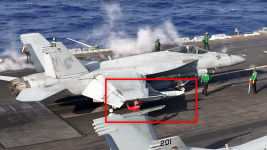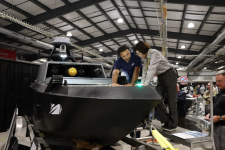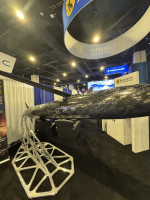Middle East: The American carrier strike group will have to do without its only oil tanker, victim of a serious incident
(
opex360.fr_25.10)
[deepl] Deployed in the Arabian Sea under the authority of US CENTCOM, the American command for the Middle East and Central Asia, the aircraft carrier strike group USS Abraham Lincoln, formed by the destroyers USS Spruance, USS O’Kane, USS Stockdale and USS Frank Petersen, will probably have to reduce its maritime and air operations in the coming days, if not weeks.
Indeed, the USNS Big Horn, the only oil tanker engaged in the region by the US Navy’s Military Sealift Command, was the victim of a serious incident while sailing off the coast of Oman, on the night of September 23 to 24.
At this time, the nature of this incident, which is under investigation, is not known. It is possible that it collided with another ship [but this is not the preferred hypothesis at this stage, according to the American specialist press] or that it hit the bottom in a place where the waters are shallow. The hypothesis that it could have hit a mine is not excluded, even if it is unlikely.
In any case, the damage observed on board the USNS Big Horn led the American Navy to tow it to a port that it has not identified. A priori, the shock occurred at its stern. And it was significant enough to cause, according to images broadcast via social networks, a leak in at least one of its technical compartments. No casualties were reported among its crew, composed mainly of civilian sailors.
The USNS Big Horn is one of the fourteen Henry J. Kaiser-class replenishment oilers still operated by the Military Sealift Command, whose main mission is to provide logistical support to US Navy ships. Of the eighteen that had been planned in the 1980s, two were cancelled when their construction was almost complete, one was sold to the Chilean Navy in 2009 and another – the USNS Walter S. Diehl – was withdrawn from service in 2022. Six others are expected to suffer the same fate between 2024 and 2027.
As a reminder, with a displacement of 42,000 tonnes at full load and a length of 206 metres, the USNS Big Horn carries up to 25,300 m³ of fuel and has holds with a total surface area of 690 m² for the transport of goods and munitions. Note that this is a single-hulled ship… while commercial tankers have a double hull.
The unavailability of the USNS Big Horn, which could last several months depending on the extent of the damage, will force the US Navy to look for alternatives to ensure the resupply of its units in the Middle East, which will probably have to increase the number of stopovers in the ports of the region. Unless the Military Sealift Command is able to deploy another ship of this type. Which, a priori, is not the case.
In addition to the 14 ships of the “Henry J. Kaiser” type, the Military Sealift Command also has two “fast combat support ships” [Supply class] as well as three new oilers-replenishment ships of the “John Lewis” class, which will have a total of 20 units [eight have just been ordered from General Dynamics NASSCO for 6.7 billion dollars].
In the meantime, the USNS Big Horn misadventure highlights the shortcomings of the American logistics fleet, which is too “small” to support all of the US Navy’s operations. And this could be detrimental to it if there is trouble in the Indo-Pacific region, especially since the Pentagon was forced to close the huge fuel depot it owned in Hawaii after the water supply system at the Pearl Harbor-Hickam base was contaminated by kerosene leaks. Leaks appeared after repairs were carried out in 2014.
One solution would be to potentially requisition the American merchant fleet. But, again, it does not have enough oil tankers to meet the US Navy’s needs in the event of a conflict.
/deepl

 www.navalnews.com
www.navalnews.com


















